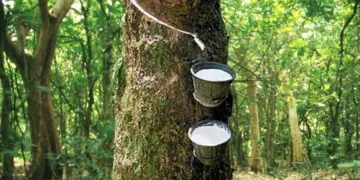To address labour shortage in rubber plantations, the “tappers census” emphasises the need of pooling workers through the networking of Rubber Producer Societies.
The first-ever census carried out by Rubber Research Institute of India (RRII) also suggested utilising the potential of female labour through self-help groups to ensure adequate labour supply.
Female participation
It is pointed out that female labour participation in rubber tapping was only a meagre 7.5 per cent out of the total 77,207 tappers, which is in sharp contrast to higher female worker participation in the large estate sector (60 per cent).
According to the report, the over-riding objective of the group approaches would be institutionalising the multiple grower dependence of the pooled labour along with promotion of Low Frequency Tapping System (LFTS).
The cumulative results of these approaches would ensure adequate labour supply, higher wage income and lower crop harvesting costs.
The census, a pioneering attempt to enumerate rubber tappers engaged in Kerala’s small rubber sector, noted that declining number of trees, predominance of single grower dependence, High Frequency Tapping System (HFTS) and the co-existence of high wage rate and low wage income all have become concerns on the tapping labour market.
This was mainly due to the persistence of organisational arrangements rooted in single grower dependence especially in the context of fragmentation of the holdings and the resultant reduction in the number of trees available for tapping, stated the report, prepared by T Siju, Binny Chandy, Tharian George and B Rajeevan of RRII.
Conflict
The genesis of the issues in the tapping labour market has been primarily rooted in the unprecedented NR market uncertainties and the resultant conflict between the survival strategies pursued by the growers and the tappers to tide over the crisis.
According to them, any realistic attempt to address the stalemate in the sector would involve ensuring adequate number of trees available for tapping with high number of tapping days coupled with Low Frequency Tapping System (LFTS) to minimise tapping costs.
The labour shortage in Kerala’s rubber smallholder sector has been one of the major policy challenges in the past one decade.
However, the absence of a reliable database on supply of rubber tappers has been a major bottleneck in formulating appropriate strategy to address the issue.
The report, therefore, suggested a major policy change to manage the existing tappable area, with the given supply of tappers and appropriate institutional interventions.
The results of the census and trends underline the need for adopting cost saving labour potential inherent in the organisational restructuring, based on multiple grower dependence and LFTS.



























